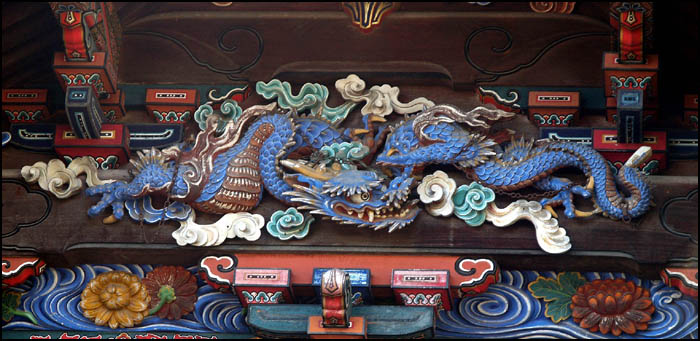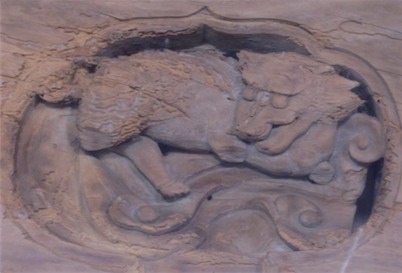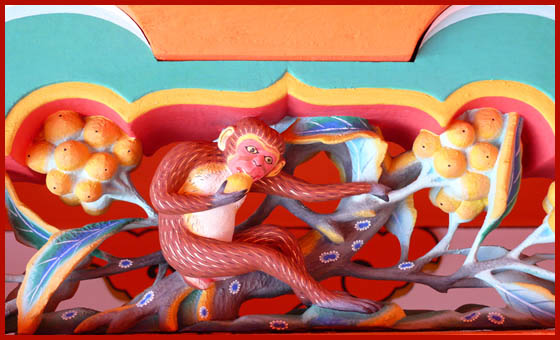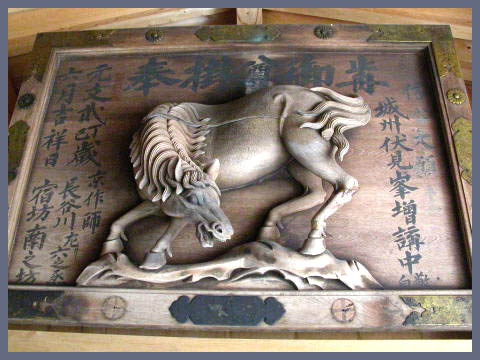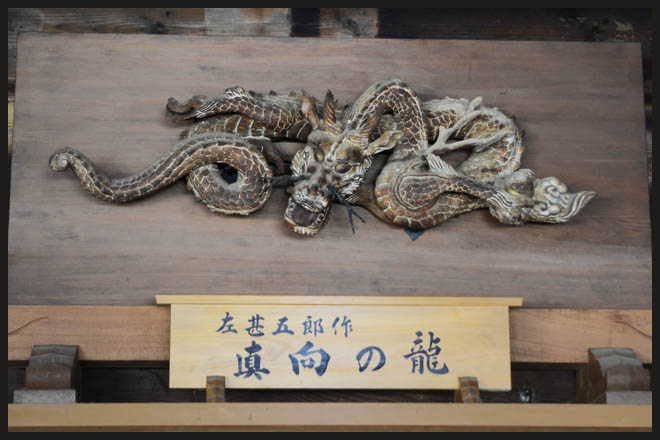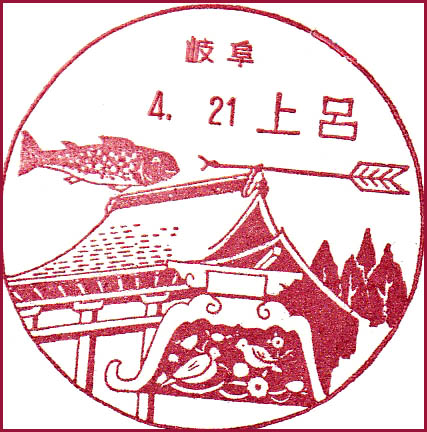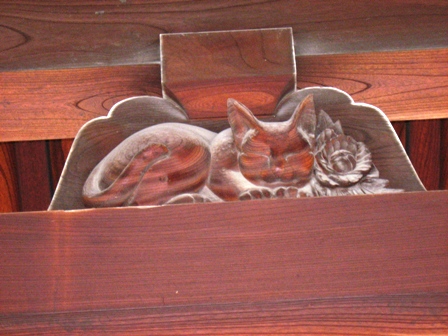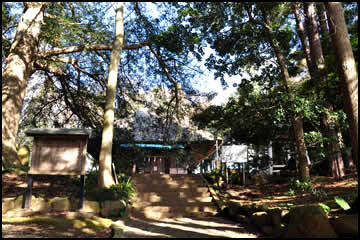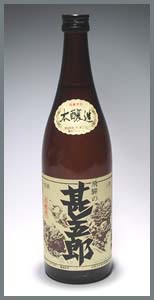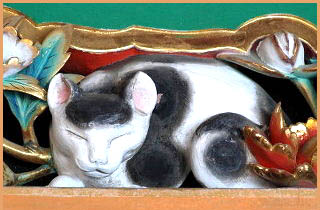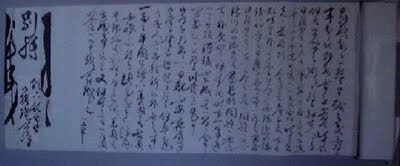[ . BACK to DARUMA MUSEUM TOP . ]. - - - PERSONS - ABC - LIST of this BLOG - - - . ::::::::::::::::::::::::::::::::::::::::::::::::::::::::::::::::::::::::::::::::::::::::::::::::::::::::::::::::::::::::::::::::::::::::::::::::::::::::::::::::::::::::::::::::::
Hidari Jingoroo 左甚五郎 Hidari Jingoro - quote - a possibly fictitious Japanese
artist, sculptor and carpenter. Although various studies suggest he was active in the early Edo period (around 1596-1644), there are controversies about the historical existence of the person. Jingorō is believed to have created many famous deity sculptures located throughout Japan, and many legends have been told about him. His famous nemuri-neko ("sleeping cat") carving is located above the Kuguri-mon Gate amidst the sacred mountain shrines and temples of Nikkō, Japan. Amongst these shrines and temples is Nikkō Tōshō-gū, a shrine that honors the Shogun Tokugawa Ieyasu.
![]() Carving of a sleeping cat at Nikkō Tōshō-gū
Carving of a sleeping cat at Nikkō Tōshō-gūJingorō was a famous Edo period artist, designer, sculpturer, carpenter, and architect. He was an apprentice for the Chief Architect Hokyo Yoheiji Yusa of the Imperial Court in Kyoto where he studied how to build temples, shrines, and sculptures. After someone cut his right hand, he learned to work with his left hand and became
Hidari Jingoroo (Hidari (左) means "left").
Stories about Jingorō are spread in wide regions in Japan.
According to one, he once saw a woman of such exceptional beauty that he made a sculpture of her. Jingorō begins to drink in the company of the sculpture, and it begins to move, following Jingorō's lead. At first it had no emotion and could only imitate Jingorō's movements. However, when he places a mirror in front of the sculpture, the woman's spirit enters and it comes to life.
- - - More in the WIKIPEDIA !Since the cat is watching over the Toshogu shrine compound, even while it is sleeping, there are no mice to worry about.
:::::::::::::::::::::::::::::::::::::::::::::::::::::::::::::::::::::::::::::::::::::::::::::::::::::::::::::::::::::::::::::::::::::::::::::::::::::::::::::::::::::::::::::::::
![]() CLICK for more of his work !
CLICK for more of his work !
Tsunagi no Ryu つなぎの龍 "the Chained Dragon"秩父夜祭(神社) Chichibu Shrine
The dragon carved by Jingoro came down every night to drink at the pond and caused much damage to the rice paddies.
So it was eventually fixed with a chain.
There are many similar stories, many relating to the dragon, but also to other animals, which come down at night to devastate the crops and cause harm to the local farmers.
(In reality it might have been the wild boars and monkeys . . . as they do it to our day.)
A similar story is told at the temple 最勝寺 in 越生町, Saitama.
A similar story is told at the shrine 大井神社 in 菊川町, Shizuoka.
A similar story is told at the temple 泉福寺 in 桶川市, Saitama.
A similar story is told at the temple 竜巣院 in 袋井市, Shizuoka.
Here the dragon got hit with a sword into its side.
A similar story is told at the temple 竜潭寺 in 引佐町, Shizuoka.
Here the hair of the dragon was cut off.
A similar story is told at the shrine 大門神社 in 浦和市, Saitama.
Its eyes were destroyed by hammering nails into them to keep the dragon in place.
A similar story is told at the temple 米倉寺 in 中井町, Kanagawa.
A similar story is told at the temple 高山寺 in 小川町, Nagano.
A similar story is told about a ryuma 竜馬
dragon-horse carved by Jingoro at the temple 伝誓寺 Densei-Ji in 岡崎市, Aichi.
.......................................................................
![]()
A similar story is told about a 虎猫
tiger-cat carved by Jingoro at the temple 法住寺 Hoju-Ji in 大塚町, Aichi.
Here the legs of the animal were cut off.
.......................................................................
![]()
A similar story is told about a 猿
monkey carved by Jingoro at the shrine 岩清水八幡宮 Iwashimizu Hachimangu in 八幡市, Kyoto.
A nail was put through his right eye.
A similar story is told about a 猿
monkey carved by Jingoro at the shrine 聖天社 in 妻沼町, Saitama.
.......................................................................
![]()
A similar story is told about a kamo 鴨
duck carved by Jingoro at the temple 東福寺 Tofuku-Ji in 流山市, Chiba.
.......................................................................
![]()
A similar story is told about a tsuru 鶴
crane carved by Jingoro at the temple 長国寺 Chokoku-Ji in 松代町, Nagano.
.......................................................................
![]()
A similar story is told about an uma 馬
horse carved by Jingoro at the temple 慈恩寺 Jion-Ji in 幾川村, Saitama
and at 牛句観音 Ushiku Kannon in 敷島町, Yamanashi.
The horse was fixed with a bridle to keep it in place.
.......................................................................
![]() source : kappanda.blog.so-net.ne.jp mamuke no ryuu 真向の竜 a dragon looking straight forward
source : kappanda.blog.so-net.ne.jp mamuke no ryuu 真向の竜 a dragon looking straight forward 成相山 成相寺
Nariai-Ji [西国三十三所巡礼] Saikoku Kannon Pilgrimage
::::::::::::::::::::::::::::::::::::::::::::::::::::::::::::::::::::::::::::::::::::::::::::::::::::::::::::::::::::::::::::::::::::::::::::::::::::::::::::::::::::::::::::::::::
.................................................... Ehime 愛媛県 ....................................................丹原町
Tanbara katame buna 片目鮒 the buna fish with one eyeThe buna in the pond of temple Kumyooji 久妙寺 Kumyo-Ji have been carved by Jingoro. The Dragon God later plucked them out of the carvings and threw them in the pond, poking out one eye.
.................................................... Gifu 岐阜県 ....................................................下呂市
Gero koi 鯉 carp![]()
The carp at the main hall of the shrine 久津八幡宮
Kuzu Hachimangu has been carved by Jingoro. It was so well done that the animal escaped every night to the nearby river Hidagawa 飛騨川 to drink water. That is why the road in front of the shrine began to crumble. So behind the carp someone carved the image of an arrow and that brought an end to the nightly outings of the carp.
. Gero Onsen 下呂温泉 Gero Hot Spring Spa . .................................................... Kumamoto 熊本県 ....................................................- - - Here is a collection of legends about Jingoro and the
shirikodama of the local Kappa, water goblins.
yamawaroo 山童 "mountain child", KappaJingoro made some straw figures and had them help with his work. When the work was finished he told them not to harm people and threw 1000 of them into the sea (to become Kappa) and 1000 into the mountains to become "yamawaro".
....................................................................... and at 河浦町
KawauraThe straw figures which Jingoro had made built a temple just over night were of no more use after the building was finished.
When he threw them into the river after that, he told them "Just go and eat the assholes of people". So they became Kappa. When such a Kappa eats rice offerings from a Buddhist altar, he can no longer kill people that way.
....................................................................... and at Amakusa, 五和町
Itsuwa Jingoro made many straw figures and built the residence of the local lord. When the work was finished he threw them into the river and told them "Just go and eat the assholes of people". This is why the Kappa have come to eat the "shirikodama".
....................................................................... and at Amakusa, 御所浦町
GoshouraWhen Jingoro was about to build a house, he got angry about one of the helpers, a good-for-nothing. He told him "Just go and eat the assholes of people" , then hit him with a hammer on the backside and threw the hammer into the sea. He made a straw figure 藁人形 and burried in the ground, which later became a Kappa.
....................................................................... and at 牛深市
Ushibuka At the time when 平清盛
Taira no Kiyomori had Hidari Jingoro do the carvings for 宮島 Miyajima
Jingoro made straw figures and had them help him. When all the work was done the "straw people" asked what to do now.
"Just go and eat the assholes of people" he said, put a nail through the head of each one and threw it into the sea.
They turned out to become Kappa and now have a plate on their head to keep the water of life in it.
(Considering Jingoro is mostly associated with the Edo period, this is an amazing tale, since Kiyomori lived around 1168.)
. 河童 Kappa legends from Kumamoto 熊本県 . .................................................... Okayama 岡山県 ....................................................阿波村
AbasonThe
dragon carved by Jingoro at the shrine 阿波八幡神社
Aba Hachiman Jinja was coming down every night to roam in the fields and cause a lot of damage. So his eyes were rubbed out and peace returned to the villge.
- Introduction of the Shrine.
- source : www.e-tsuyama.com - .................................................... Osaka 大阪市 ....................................................At the temple Shitenno-Ji 四天王寺 there is a carving of a sleeping cat.
In the New Year's morning it is always calling out loudely.
![]()
So beside the famous cat in Nikko there is one more.
The cat carving amulet was a precious amulet to keep mice away from the silk worms in former times.
.................................................... Niigata 新潟県 ....................................................月潟村
Tsukigata ryuu 龍 DragonOnce large ships could not move in the harbour and rumor had it the culprit was the Dragon carved in the local temple.
So people hit a nail into its tongue.
From that day on the ships could pass and move freely, but by sunset on that day, the temple hall burned down completely.
.......................................................................
浦佐町
UrasaJingoro spent some time in Echigo. There he heared the legend of Bishamonten who exterminated a
wild mountain cat山猫.
So he carved a mask of the mountain cat and fixed it to the entrance of the 毘沙門堂 Bishamon Hall.
After the main festival every year on the 7th day of the 3rd lunar month at midnight, the cat is howling.
Another legend tells that the mountain cat saved the Bishamon Hall from fire and the mask is now an amulet to prevent fire.
![]()
Urasa no neko men 浦佐の猫面
cat mask from Urasa . Niigata Folk Art - 新潟県 . .......................................................................
Sado Island, 畑野町
HatanoJingoro carved a
cock 鶏 for the shrine Kamo Jinja 加茂神社. He used a living cock borrowed from the neighborhood for his model. When the carving was done, the cock died all of a sudden. In his turn, the wood-carved cock was now crowing every morning. The villagers felt quite eery and eventually it was shot with an arrow in its breast. Then silence returned.
.................................................... Saitama 埼玉県 .................................................... . Chichibu Jinja 秩父神社 Chichibu shrine . ![]()
kosodate no tora 子宝・子育ての虎
mother tiger and her children (The tiger looks more like a leopard with her fur patterns . . .)
.......................................................................
浦和市
UrawaAfter a funeral at the temple 国昌寺 Kokusho-Ji a
dragon carved by Jingoro came down to eat the dead body, but then damaged the fields while suffering from a stomach ace. When the villagers hit some nails into the wooden head, all calmed down.
![]()
kugizuke no ryuu 釘付けの龍
"the nailed-down dragon"A similar legend is told at 越谷市 Koshigaya. .
.................................................... Shizuoka 静岡県 ....................................................Numazu 沼津市
wara ningyoo 藁人形 straw dolls, straw figures Jingoro was ordered to rebuild the 観音堂 Kannon Hall. Since the festival day was close, there was not much time. So Jingoro asked the villagers to make many human straw figures. He blew life in them and they finished the hall in three days and three nights. Since it was finished in the early morning, it was called
![]() source : city.numazu.shizuoka.jp Akeno Kannon 赤野観音 "Kannon in the Red (morning sun) Field". ................................................... Wakayama 和歌山県 ....................................................
source : city.numazu.shizuoka.jp Akeno Kannon 赤野観音 "Kannon in the Red (morning sun) Field". ................................................... Wakayama 和歌山県 ....................................................赤松寺
Akamatsu temple![]() statue of a tiger
statue of a tiger虎置物
.................................................... Yamaguchi 山口県 ....................................................Shimonoseki 下関市
![]()
Temple 引接寺
Injo-Ji carving in the ceiling
.................................................... Yamanashi 山梨県 ....................................................Kofu 中道町
Nakamichibakeneko 化け猫 the monster catWhen Jingoro walked along Yamazaki Shinden 山崎新田 he passed by a old woman suffering pain, so he heaved her on his back and carried her on. But is was in fact the stone statue of Jizo 石地蔵. When Jingoro reached the home of the old woman, there was only a servant telling him, the grandma of the home had just died and grandpa was on his way to the temple. The servant had been told not to let the fire go out, but he was tired and had started to nap. At that moment the dead old grandma had tried to get out of the house and Jingoro tried to hold her back as she tried to climb on the roof. Just than grandpa came back, took a stone, threw it up the roof and hit the grandma.
Since the fire went out, the cat from the temple had sneaked in, walked on the roof and tried to steal the dead body.
.......................................................................
- quote - Toyo-kan (Mountain Lodge) The lodge worships the Manekineko (lucky beckoning cat) and Hachidai Ryuo (Eight Great Dragon Kings) (Buddhism god) which are assumed to be carved by the noted sculptor Hidari Jingoro.
- source : www.yamanashi-kankou.jp - ::::::::::::::::::::::::::::::::::::::::::::::::::::::::::::::::::::::::::::::::::::::::::::::::::::::::::::::::::::::::::::::::::::::::::::::::::::::::::::::::::::::::::::::::::
![]() 飛騨の甚五郎 Jingoro from Hida - Sake
飛騨の甚五郎 Jingoro from Hida - Sake 名工、左甚五郎の名にあやかった
飛騨の清酒です。 シャープな切れ味,辛口ごのみの男酒です。
- source : www.hidaroman.com - carpenter joys -
today we drink
on Jingoro ! Gabi Greve, July 2015
::::::::::::::::::::::::::::::::::::::::::::::::::::::::::::::::::::::::::::::::::::::::::::::::::::::::::::::::::::::::::::::::::::::::::::::::::::::::::::::::::::::::::::::::::
- - - - - H A I K U - - - - -寒菊や大工は左甚五郎 kangiku ya daiku wa hidari jingoroo
chrysanthemum in the cold -
the carpenter is Hidari
Jingoro . Masaoka Shiki 正岡子規. . kangiku 寒菊 (かんぎく) chrysanthemum in the cold . - kigo for all winter -..............................................................................................................................................
耳立てて甚五郎猫は大昼寝 mimi tatete Jingoro neko wa oo hirune
with ears pricked up
the cat from Jingoro
takes its nap 角田よし子 Tsunoda Yoshiko
![]()
::::::::::::::::::::::::::::::::::::::::::::::::::::::::::::::::::::::::::::::::::::::::::::::::::::::::::::::::::::::::::::::::::::::::::::::::::::::::::::::::::::::::::::::::::
Yokai database 妖怪データベース - -
- source: www.nichibun.ac.jp - - Reference - Japanese - - Reference - English - . . minwa 民話 folktales / densetsu 伝説 Japanese Legends . . - Introduction - . Legends about animals 動物と伝説 . ..............................................................................................................................................
. Welcome to Edo 江戸 ! . . Woodwork in Edo . - - - #hidarijingoro #jingoro - - - ::::::::::::::::::::::::::::::::::::::::::::::::::::::::::::::::::::::::::::::::::::::::::::::::::::::::::::::::::::::::::::::::::::::::::::::::::::::::::::::::::::::::::::::::::
![]() Join the friends on facebook !. - - - PERSONS - ABC - LIST of this BLOG - - - . [ . BACK to DARUMA MUSEUM TOP . ][ . BACK to WORLDKIGO . TOP . ]
Join the friends on facebook !. - - - PERSONS - ABC - LIST of this BLOG - - - . [ . BACK to DARUMA MUSEUM TOP . ][ . BACK to WORLDKIGO . TOP . ]::::::::::::::::::::::::::::::::::::::::::::::::::::::::::::::::::::::::::::::::::::::::::::::::::::::::::::::::::::::::::::::::::::::::::::::::::::::::::::::::::::::::::::::::::
![]()
![]()
![]()






